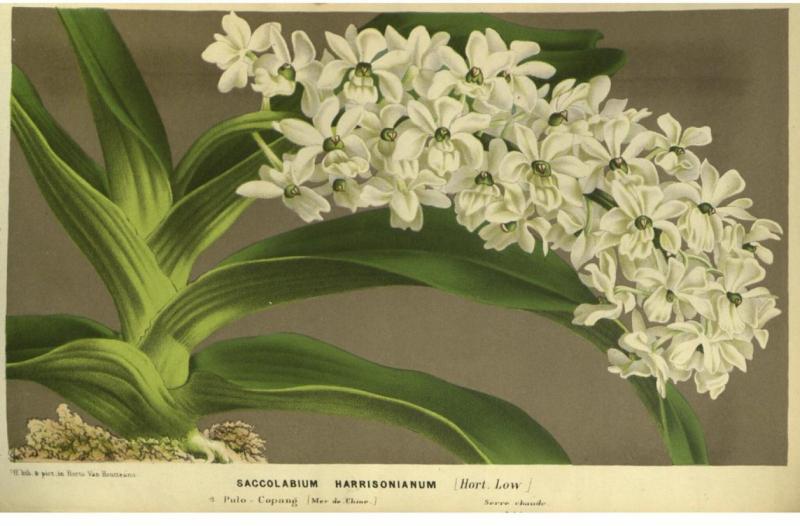Rhynchostylis gigantea
Also known as: The Giant Rhynchostylis or Vanda violacea Saccolabium giganteum var. petotianum Saccolabium giganteum var. illustre Rhynchostylis gigantea f. harrisoniana Rhynchostylis gigantea h.v. albasepala Rhynchostylis gigantea h.f. rubra Rhynchostylis gigantea h.f. rubrum Rhynchostylis gigantea h.f. alba Saccolabium violaceum var. harrisonianum Rhynchostylis gigantea h.v. viraphandhuii Rhynchostylis gigantea h.v. devarajunii Rhynchostylis gigantea peach form Rhynchostylis gigantea h.f. maculata Anota densiflora Anota violacea Anota harrisoniana Rhynchostylis gigantea ssp. gigantea Rhynchostylis gigantea ssp. violacea Saccolabium albolineatum Vanda densiflora Anota hainanensis Rhynchostylis gigantea (Sagarik's strain) Saccolabium harrisonianum Vanda hainanensis Rhynchostylis gigantea h.v. vivaphandhuli Saccolabium violaceum Rhynchostylis gigantea h.v. harrisoniana Rhynchostylis gigantea h.v. harrisonianum Rhynchostylis gigantea Sagarik's strain Saccolabium giganteum Rhynchostylis gigantea h.v. petotiana Rhynchostylis gigantea h.v. illustris Rhynchostylis gigantea h.v. rattana Rhynchostylis violacea Rhynchostylis gigantea red form Rhynchostylis gigantea h.v. alba h.v. Prapon Gastrochilus giganteus In Thailand - Chang dam - Chang kra in the subfamily: Epidendroideae
Native to: Cambodia China Indonesia Singapore Thailand
General Information
The Giant Rhynchostylis is a monopodial warm to hot growing orchid belonging to the sub family Epidendroideae native to Cambodia, China, Indonesia, Singapore, and Thailand.
Plant Description
Monopodial. Grows to 61cm. Each new growth has numerous leathery thick leaves that grow to 5-30cm long
Flowers
Numerous fragrant blossoms appear during Winter
Fragrance
The orchid is fragrant.
Blooming Season
- Winter
Substrate(s)
- Coarse
- Medium
- Bark
- Charcoal
- IsFragrant
Climate
The orchids are well adapted for hot weather, accompanied by sporadic, unpredictable rainfall and a generally dry climate. They can tolerate a lot of neglect as they are quite used to it, however they can be prone to underwatering and may collapse in cold, wet weather.
For this reason it's best to dedicate a sheltered, protected area for them where the watering can be controlled, such as a corner of a greenhouse or in a sheltered balcony. They can also do well hung near the roof of a shadehouse or sheltered greenhouse where they receive the extra heat but not as much water as other plants.
Grows at low elevations. Rainfall ranges from 10mm to 300mm per day, heaviest in September and lightest in December. Humidity ranges from 72% to 83%, highest in September and lowest in January. Temperature ranges from 20C to 35C, highest in April (26C to 35C) and lowest in January (20C to 31C).Watering
These orchids prefer a wet-dry cycle between waterings, they should be watered frequently but only when the moisture is approaching dryness, where the pot feels light and/or the media looks dry. Keep an eye on mounted orchids in warm weather as they may dehydrate quickly.
Keep moisture levels up during hot weather as the plant is prone to dehydrationFertiliser
These orchids do not need to be regularly fertilised and roots may be sensitive to salt build-up, dying back and therefore impairing the plants growth or even killing it.
If fertilising, use half to quarter of the recommended amount of fertiliser. If they receive fertiliser as part of a collection, be sure to flush out the pots regularly with fresh water and monitor the roots by checking how much resistance is given by the plant when nudged in its pot or mount. If the plant becomes wobbly or loose, repot in fresh mix or rinse the media/mount thoroughly and do not fertilise for at least 3 months.
Use balanced fertiliser during Spring and Summer. Apply fertiliser regularly at half strength year round. This plant is sensitive so apply fertiliser sparingly at one quarter recommended strength or less. Use a high Nitrogen fertiliser during Spring and Summer. Use a high Phosphorous fertiliser during Summer.Potting
This plant does very well in baskets or suspended pots Repotting is best done annually.





















